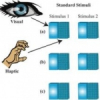Free Online Productivity Tools
i2Speak
i2Symbol
i2OCR
iTex2Img
iWeb2Print
iWeb2Shot
i2Type
iPdf2Split
iPdf2Merge
i2Bopomofo
i2Arabic
i2Style
i2Image
i2PDF
iLatex2Rtf
Sci2ools
111
click to vote
Publication
Multisensory Oddity Detection as Bayesian Inference
A key goal for the perceptual system is to optimally combine
information from all the senses that may be available in order to
develop the most accurate and unified picture possible of the outside
world. The contemporary theoretical framework of ideal observer
maximum likelihood integration (MLI) has been highly successful in
modelling how the human brain combines information from a variety of
different sensory modalities. However, in various recent experiments
involving multisensory stimuli of uncertain correspondence, MLI breaks
down as a successful model of sensory combination. Within the paradigm
of direct stimulus estimation, perceptual models which use Bayesian
inference to resolve correspondence have recently been shown to
generalize successfully to these cases where MLI fails. This approach
has been known variously as model inference, causal inference or
structure inference. In this paper, we examine causal uncertainty in
another important class of multi-sensory p...
| Added | 15 Feb 2011 |
| Updated | 15 Feb 2011 |
| Type | Journal |
| Year | 2009 |
| Where | PLoS |
| Authors | Timothy Hospedales and Sethu Vijayakumar |
Comments (0)






